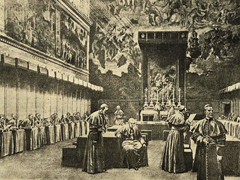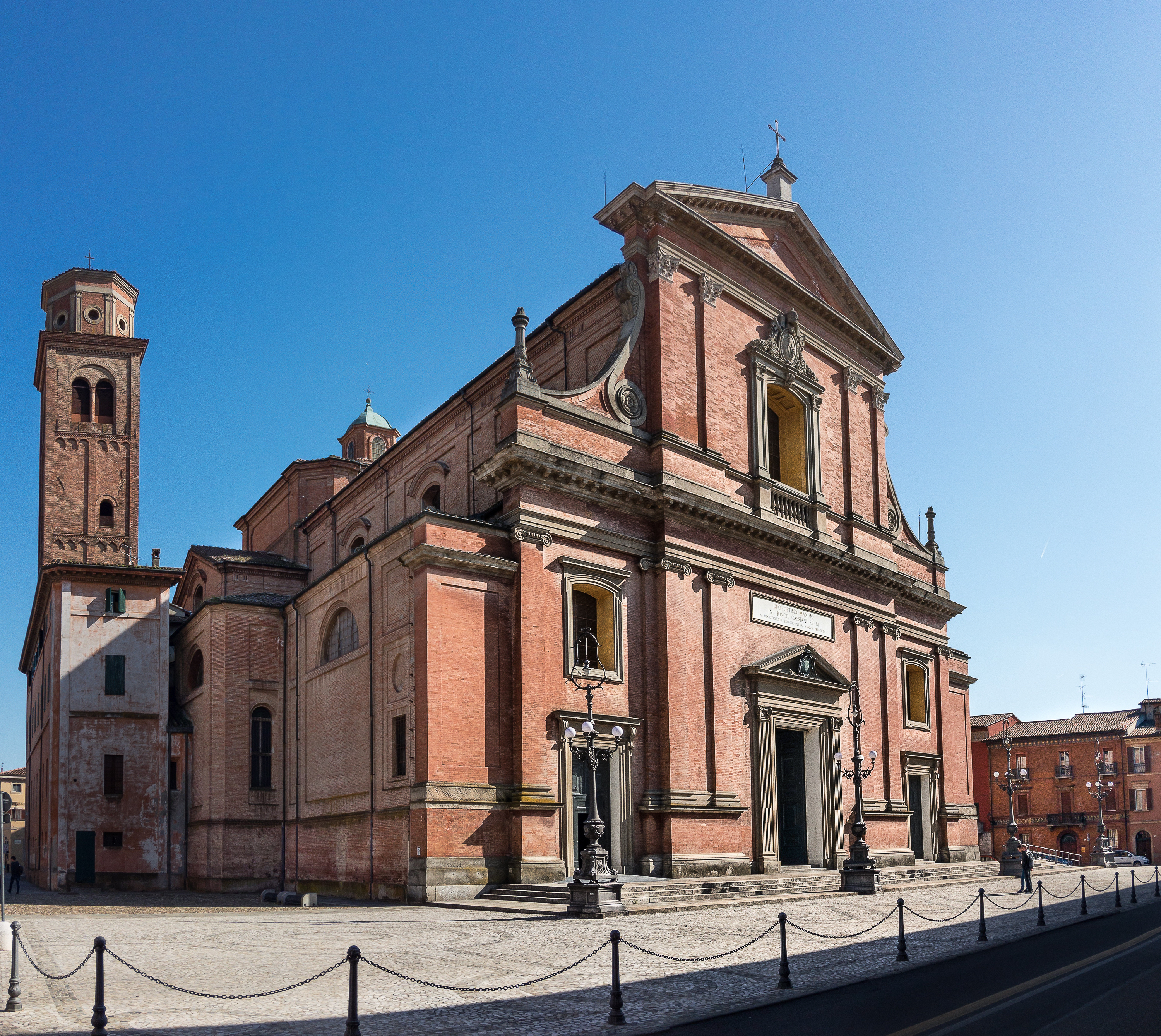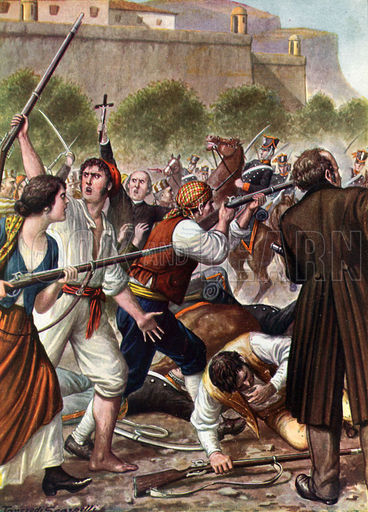|
1846 Papal Conclave
A papal conclave was held from 14 to 16 June 1846 to elect a new pope to succeed Gregory XVI, who had died in 1 June. Of the 62 eligible cardinal electors, all but twelve attended. On the fourth ballot, the conclave elected Cardinal Giovanni Mastai-Ferretti, the Roman Catholic Diocese of Imola, archbishop-bishop of Imola. After accepting his election, he Papal name, took the name ''Pius IX''. This conclave was the last to elect a ruler of the Papal States, the extensive lands around Rome and Central Italy which the Catholic Church governed until 1870. Background It was the issue of the government of the Papal States that was to prove central to the 1846 conclave. The College of Cardinals was split into two factions. The conservatives wished to see a continuation of papal Absolute monarchy, absolutism in the governance of the Papal States, a continuation of the hardline policies of Pope Gregory XVI and his right-wing Cardinal Secretary of State, Secretary of State, Luigi Lambrus ... [...More Info...] [...Related Items...] OR: [Wikipedia] [Google] [Baidu] |
Quirinal Palace
The Quirinal Palace ( ) is a historic building in Rome, Italy, the main official residence of the President of Italy, President of the Italian Republic, together with Villa Rosebery in Naples and the Tenuta di Castelporziano, an estate on the outskirts of Rome, some from the centre of the city. It is located on the Quirinal Hill, the highest of the seven hills of Rome in an area colloquially called Monte Cavallo. It has served as the residence for thirty popes, four King of Italy, kings of Italy and twelve presidents of the Italian Republic. The Quirinal Palace, originality a papal residence built by Pope Gregory XIII, was selected by Napoleon to be his residence ''par excellence'' as Emperor of the French, emperor. However, he never stayed there because of the French defeat in 1814 and the subsequent Concert of Europe, European Restoration. The palace extends for an area of and is the List of largest palaces, eleventh-largest palace in the world. History Origins The curre ... [...More Info...] [...Related Items...] OR: [Wikipedia] [Google] [Baidu] |
Luigi Lambruschini
Luigi Lambruschini (6 March 1776 – 12 May 1854) was an Italian cardinal of the Roman Catholic Church in the mid nineteenth century. He was a member of the Clerics Regular of St. Paul and served in the diplomatic corps of the Holy See. Biography Early life The youngest of ten children, he was born in Sestri Levante, then part of the independent Republic of Genoa, to Bernardo and Pellegrina Raggi Lambruschini, and baptized Emmanuele Nicolo. His older brother, Giovanni Battista Lambruschini became bishop of the Diocese of Orvieto. Lambruschini attended a Jesuit school in Santa Margherita Ligure, and then the Oratorio di San Bartolomeo in Bordighera, run by the Order of the Barnabites. He entered the order in 1793, and after a novitiate, pronounced solemn vows in November 1794, taking the name of Luigi. He was then to Macerata for further study, took minor orders in Rome in 1797, and was ordained a priest back home in Sestri Levante in January 1799. He then taught Barnabite ... [...More Info...] [...Related Items...] OR: [Wikipedia] [Google] [Baidu] |
Papal Coronation
A papal coronation was the formal ceremony of the placing of the papal tiara on a newly elected pope. The first recorded papal coronation was of Pope Nicholas I in 858. The most recent was the 1963 coronation of Paul VI, who soon afterwards abandoned the practice of wearing the tiara. To date, none of his successors have used the tiara, and their papal inauguration celebrations have included no coronation ceremony, although any future pope may elect to restore the use of the tiara at any point during his pontificate. The papal inauguration celebration, with or without a coronation, has only symbolic significance, as a pope assumes office immediately upon accepting his election during the conclave. In Spanish language, Spanish, the term (English language, English: "Pontifical Coronation") is sometimes used for the canonical coronation of religious images through a formal, expressed Pontifical decree by a reigning pope. Ritual On the day of election When a Papal conclave, con ... [...More Info...] [...Related Items...] OR: [Wikipedia] [Google] [Baidu] |
Archbishop Of Milan
The Archdiocese of Milan (; ) is a Latin Church ecclesiastical territory or archdiocese of the Catholic Church in Italy which covers the areas of Milan, Monza, Lecco and Varese. It has long maintained its own Latin liturgical rite usage, the Ambrosian rite, which is still used in the greater part of the diocesan territory. Among its past archbishops, the better known are Ambrose, Charles Borromeo, Pope Pius XI and Pope Paul VI. The Archdiocese of Milan is the metropolitan see of the ecclesiastical province of Milan, which includes the suffragan dioceses of Bergamo, Brescia, Como, Crema, Cremona, Lodi, Mantova, Pavia, and Vigevano."Archdiocese of Milano " '' Catholic-Hierarchy.org'' David M. Cheney. Retri ... [...More Info...] [...Related Items...] OR: [Wikipedia] [Google] [Baidu] |
Ferdinand I Of Austria
Ferdinand I ( 19 April 1793 – 29 June 1875) was Emperor of Austria from March 1835 until his abdication in December 1848. He was also King of Hungary, King of Croatia, Croatia and King of Bohemia, Bohemia (as Ferdinand V), King of Lombardy–Venetia and holder of other lesser titles (see grand title of the Emperor of Austria). Due to his passive but well-intentioned character, he gained the sobriquet The Benign () or The Benevolent (, Polish: ''Ferdynand Dobrotliwy''). Ferdinand succeeded his father Francis II, Holy Roman Emperor, Francis I upon his death on 2 March 1835. He was incapable of ruling the empire because of severe epilepsy, so his father, before he died, made a will promulgating that Ferdinand should consult his uncle Archduke Louis of Austria, Archduke Louis on all aspects of internal policy and urged him to be influenced by Klemens Wenzel, Prince von Metternich, Prince Metternich, Austria's Foreign Minister.A. J. P. Taylor, Taylor, A. J. P.: "The Habsburg Monarc ... [...More Info...] [...Related Items...] OR: [Wikipedia] [Google] [Baidu] |
Cardinal (Catholicism)
A cardinal is a senior member of the clergy of the Catholic Church. As titular members of the clergy of the Diocese of Rome, they serve as advisors to the pope, who is the bishop of Rome and the Head of the Church#Catholic Church, visible head of the worldwide Catholic Church. Cardinals are chosen and formally created by the pope, and typically hold the title for life. Collectively, they constitute the College of Cardinals. The most solemn responsibility of the cardinals is to elect a new pope in a Papal conclave, conclave, almost always from among themselves, with a few historical exceptions, when the Holy See is Sede vacante#Vacancy of the Holy See, vacant. During the period between a pope's death or resignation and the election of his successor, the day-to-day governance of the Holy See is in the hands of the College of Cardinals. The right to participate in a conclave is limited to cardinals who have not reached the age of 80 years by the day the vacancy occurs. With the pope ... [...More Info...] [...Related Items...] OR: [Wikipedia] [Google] [Baidu] |
1903 Conclave
A papal conclave was held from 31 July to 4 August 1903 to elect a new pope to succeed Leo XIII, who had died on 20 July. Of the 64 eligible cardinal electors, all but two attended. On the seventh ballot, the conclave elected Cardinal Giuseppe Sarto, the patriarch of Venice. After accepting his election, he took the name ''Pius X''. This was the first conclave to host a representative from North America—James Gibbons, archbishop of Baltimore—and the first to incorporate a non-European born cardinal since the 1471 papal conclave that featured Cardinal Bessarion of Trebizond. Emperor Franz Joseph of Austria asserted the right claimed by certain Catholic rulers to veto a candidate for the papacy, blocking the election of the leading candidate, Cardinal Secretary of State Mariano Rampolla. Background The pontificate of Leo XIII came to an end on 20 July 1903 after 25 years, longer than any previous pope, except his predecessor Pius IX; together, they had reigned for 57 yea ... [...More Info...] [...Related Items...] OR: [Wikipedia] [Google] [Baidu] |
Protodeacon
Protodeacon derives from the Greek ''proto-'' meaning 'first' and ''diakonos'', which is a standard ancient Greek word meaning "assistant", "servant", or "waiting-man". The word in English may refer to any of various clergy, depending upon the usage of the particular church in question. Eastern Orthodox and Eastern Catholic churches Protodeacon is an honorific rank given to certain married deacons in Eastern Christian churches. In the Russian Orthodox Church it is an honorary title given to married deacons, as a mark of which, the clergyman is entitled to wear a burgundy-colored skufia. The equivalent rank for hierodeacons—i.e., monastic deacons—is archdeacon. The senior deacon of a cathedral or principal church may be awarded the title of protodeacon. In the Greek usage, the chief deacon who is attached to the person of a bishop is called an archdeacon. In the Slavic usage a protodeacon or archdeacon wears a distinctive orarion (deacon's stole). The title of protodeacon ... [...More Info...] [...Related Items...] OR: [Wikipedia] [Google] [Baidu] |
Imola
Imola (; or ) is a city and ''comune'' in the Metropolitan City of Bologna, located on the river Santerno, in the Emilia-Romagna region of northern Italy. The city is traditionally considered the western entrance to the historical region Romagna. The city is best-known as the home of the Autodromo Enzo e Dino Ferrari which hosts the Formula One Emilia Romagna Grand Prix and formerly hosted the San Marino Grand Prix, named after the independent nation of San Marino around 100 km to the south. History Sometime around 82 Common Era, BCE, the Roman dictator L. Cornelius Sulla founded the city, which was originally known eponymously in ancient times as ''Forum Cornelii'' ("Forum of Cornelius"). The city was an agricultural and trading centre, famous for its ceramics (art), ceramics. The name Imola was first used in the 7th century by the Lombards, who applied it to the fortress (the present Castellaccio, the construction of which is attributed to the Lombard Clefi), whence the ... [...More Info...] [...Related Items...] OR: [Wikipedia] [Google] [Baidu] |
Patriotism
Patriotism is the feeling of love, devotion, and a sense of attachment to one's country or state. This attachment can be a combination of different feelings for things such as the language of one's homeland, and its ethnic, cultural, political, or historical aspects. It may encompass a set of concepts closely related to nationalism, mostly civic nationalism and sometimes cultural nationalism. Terminology and usage An excess of patriotism is called ''chauvinism''; another related term is ''jingoism''. The English language, English word "patriot" derived from "compatriot", in the 1590s, from Middle French in the 15th century. The French word's and originated directly from Late Latin "fellow-countryman" in the 6th century. From Greek language, Greek "fellow countryman", from "of one's fathers", "fatherland". The term ''patriot'' was "applied to barbarians who were perceived to be either uncivilized or primitive and who had only a common Patris or fatherland." The origi ... [...More Info...] [...Related Items...] OR: [Wikipedia] [Google] [Baidu] |
Carbonari
The Carbonari () was an informal network of Secret society, secret revolutionary societies active in Italy from about 1800 to 1831. The Carbonari may have further influenced other revolutionary groups in France, Portugal, Spain, Brazil, Uruguay, the Ottoman Empire, and Russia. Although their goals often had a Patriotism, patriotic and Liberalism, liberal basis, they lacked a clear immediate political agenda. They were a focus for those unhappy with the repressive political situation in Italy following 1815, especially in the south of the Italian peninsula. Members of the Carbonari, and those influenced by them, took part in important events in the process of Unification of Italy, Italian unification (called the ''Risorgimento''), especially the failed Revolutions of 1820, Revolution of 1820, and in the further development of Italian nationalism. The chief purpose was to defeat tyranny and establish a constitutional government. In the north of Italy, other groups, such as the Ade ... [...More Info...] [...Related Items...] OR: [Wikipedia] [Google] [Baidu] |
Carlo Gaetano Gaisruck
Karl Kajetan von Gaisruck (Italian: Carlo Gaetano (di) Gaisruck) (1769–1846) was an Austrian Cardinal and the archbishop of Milan from 1816 to 1846. He also held the title of ''Graf'' or Count. Early life Gaisruck was born on 7 August 1769 in Klagenfurt, Archduchy of Austria. He studied in Salzburg, at the ''Collegium Germanicum'' in Pavia, and he received a doctorate in liberal arts and philosophy from the University of Salzburg. He was elected the canon of the Cathedral chapter of Passau in September 1788. In 1800 he was ordained a Catholic priest. The next year he was appointed auxiliary bishop of Passau, with the title of Bishop of Derbe, and accordingly he was consecrated bishop on 23 August 1801 by the last Prince-Bishop of Passau Leopold Leonard von Thun. After the secularization of the bishopric of Passau in 1803, Gaisruck had to leave the town and served as parish priest in the Diocese of Linz till his appointment as Archbishop of Milan. Archbishop of Milan The ... [...More Info...] [...Related Items...] OR: [Wikipedia] [Google] [Baidu] |






